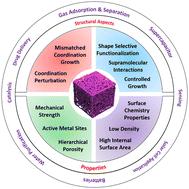当前位置:
X-MOL 学术
›
Chem. Soc. Rev.
›
论文详情
Our official English website, www.x-mol.net, welcomes your
feedback! (Note: you will need to create a separate account there.)
Hierarchical porous metal–organic gels and derived materials: from fundamentals to potential applications
Chemical Society Reviews ( IF 40.4 ) Pub Date : 2022-10-21 , DOI: 10.1039/d2cs00585a Jacek K Wychowaniec 1, 2 , Haneesh Saini 3 , Błażej Scheibe 4 , Deepak P Dubal 5 , Andreas Schneemann 6 , Kolleboyina Jayaramulu 3
Chemical Society Reviews ( IF 40.4 ) Pub Date : 2022-10-21 , DOI: 10.1039/d2cs00585a Jacek K Wychowaniec 1, 2 , Haneesh Saini 3 , Błażej Scheibe 4 , Deepak P Dubal 5 , Andreas Schneemann 6 , Kolleboyina Jayaramulu 3
Affiliation

|
Metal–organic gels (MOGs) emerged as a novel class of functional soft materials in which the scaffolding framework is fabricated by metal–ligand coordination in combination with other supramolecular interactions (for example, hydrogen bonding or π–π stacking). Through the combination of organic and inorganic (metal/metal–oxo clusters) building blocks, significant steps forward have been made in the development of new electrochemical sensors, superhydrophobic materials and ion storage devices, among others. These leaps forward are to some extend induced by the intrinsic hierarchical microporous/mesoporous pore structure of these metal–organic materials. Within this review we give an overview of recent developments of this growing field. First, we shed light onto the parallels to the well-established field of conventional gels and outline similarities and differences. Afterwards, we classify different types of MOGs according to their architectural/structural nature: (1) pristine MOGs, (2) hybrid MOGs, (3) crosslinking-based MOGs and (4) MOG-derived materials. Furthermore, we look at the different properties of MOGs and the requirements for the preparation of spatially patterned macro-structured MOGs by emerging additive manufacturing technologies. Moreover, different potential fields of application for MOGs and MOG derived materials are critically evaluated and potential improvements and pitfalls in comparison to traditional gel-based materials are given. Finally, a comprehensive outlook into future directions for the development of MOGs is provided.
中文翻译:

分层多孔金属有机凝胶和衍生材料:从基础到潜在应用
金属有机凝胶(MOGs)作为一类新型功能性软材料出现,其中支架框架是通过金属-配体配位结合其他超分子相互作用(例如氢键或π-π堆积)制造的。通过有机和无机(金属/金属-氧簇)结构单元的结合,在开发新型电化学传感器、超疏水材料和离子存储装置等方面取得了重大进展。这些飞跃在某种程度上是由这些金属有机材料固有的分级微孔/中孔孔结构引起的。在这篇评论中,我们概述了这个不断发展的领域的最新发展。第一的,我们阐明了与传统凝胶的成熟领域的相似之处,并概述了相似之处和不同之处。之后,我们根据其建筑/结构性质对不同类型的 MOG 进行分类:(1)原始 MOG,(2)混合 MOG,(3)基于交联的 MOG 和(4)MOG 衍生材料。此外,我们研究了 MOG 的不同特性以及通过新兴增材制造技术制备空间图案化宏观结构 MOG 的要求。此外,对 MOG 和 MOG 衍生材料的不同潜在应用领域进行了严格评估,并给出了与传统凝胶基材料相比的潜在改进和缺陷。最后,对MOGs的未来发展方向进行了全面展望。我们根据其建筑/结构性质对不同类型的 MOG 进行分类:(1)原始 MOG,(2)混合 MOG,(3)基于交联的 MOG 和(4)MOG 衍生材料。此外,我们研究了 MOG 的不同特性以及通过新兴增材制造技术制备空间图案化宏观结构 MOG 的要求。此外,对 MOG 和 MOG 衍生材料的不同潜在应用领域进行了严格评估,并给出了与传统凝胶基材料相比的潜在改进和缺陷。最后,对MOGs的未来发展方向进行了全面展望。我们根据其建筑/结构性质对不同类型的 MOG 进行分类:(1)原始 MOG,(2)混合 MOG,(3)基于交联的 MOG 和(4)MOG 衍生材料。此外,我们研究了 MOG 的不同特性以及通过新兴增材制造技术制备空间图案化宏观结构 MOG 的要求。此外,对 MOG 和 MOG 衍生材料的不同潜在应用领域进行了严格评估,并给出了与传统凝胶基材料相比的潜在改进和缺陷。最后,对MOGs的未来发展方向进行了全面展望。此外,我们研究了 MOG 的不同特性以及通过新兴增材制造技术制备空间图案化宏观结构 MOG 的要求。此外,对 MOG 和 MOG 衍生材料的不同潜在应用领域进行了严格评估,并给出了与传统凝胶基材料相比的潜在改进和缺陷。最后,对MOGs的未来发展方向进行了全面展望。此外,我们研究了 MOG 的不同特性以及通过新兴增材制造技术制备空间图案化宏观结构 MOG 的要求。此外,对 MOG 和 MOG 衍生材料的不同潜在应用领域进行了严格评估,并给出了与传统凝胶基材料相比的潜在改进和缺陷。最后,对MOGs的未来发展方向进行了全面展望。对 MOG 和 MOG 衍生材料的不同潜在应用领域进行了严格评估,并给出了与传统凝胶基材料相比的潜在改进和缺陷。最后,对MOGs的未来发展方向进行了全面展望。对 MOG 和 MOG 衍生材料的不同潜在应用领域进行了严格评估,并给出了与传统凝胶基材料相比的潜在改进和缺陷。最后,对MOGs的未来发展方向进行了全面展望。
更新日期:2022-10-21
中文翻译:

分层多孔金属有机凝胶和衍生材料:从基础到潜在应用
金属有机凝胶(MOGs)作为一类新型功能性软材料出现,其中支架框架是通过金属-配体配位结合其他超分子相互作用(例如氢键或π-π堆积)制造的。通过有机和无机(金属/金属-氧簇)结构单元的结合,在开发新型电化学传感器、超疏水材料和离子存储装置等方面取得了重大进展。这些飞跃在某种程度上是由这些金属有机材料固有的分级微孔/中孔孔结构引起的。在这篇评论中,我们概述了这个不断发展的领域的最新发展。第一的,我们阐明了与传统凝胶的成熟领域的相似之处,并概述了相似之处和不同之处。之后,我们根据其建筑/结构性质对不同类型的 MOG 进行分类:(1)原始 MOG,(2)混合 MOG,(3)基于交联的 MOG 和(4)MOG 衍生材料。此外,我们研究了 MOG 的不同特性以及通过新兴增材制造技术制备空间图案化宏观结构 MOG 的要求。此外,对 MOG 和 MOG 衍生材料的不同潜在应用领域进行了严格评估,并给出了与传统凝胶基材料相比的潜在改进和缺陷。最后,对MOGs的未来发展方向进行了全面展望。我们根据其建筑/结构性质对不同类型的 MOG 进行分类:(1)原始 MOG,(2)混合 MOG,(3)基于交联的 MOG 和(4)MOG 衍生材料。此外,我们研究了 MOG 的不同特性以及通过新兴增材制造技术制备空间图案化宏观结构 MOG 的要求。此外,对 MOG 和 MOG 衍生材料的不同潜在应用领域进行了严格评估,并给出了与传统凝胶基材料相比的潜在改进和缺陷。最后,对MOGs的未来发展方向进行了全面展望。我们根据其建筑/结构性质对不同类型的 MOG 进行分类:(1)原始 MOG,(2)混合 MOG,(3)基于交联的 MOG 和(4)MOG 衍生材料。此外,我们研究了 MOG 的不同特性以及通过新兴增材制造技术制备空间图案化宏观结构 MOG 的要求。此外,对 MOG 和 MOG 衍生材料的不同潜在应用领域进行了严格评估,并给出了与传统凝胶基材料相比的潜在改进和缺陷。最后,对MOGs的未来发展方向进行了全面展望。此外,我们研究了 MOG 的不同特性以及通过新兴增材制造技术制备空间图案化宏观结构 MOG 的要求。此外,对 MOG 和 MOG 衍生材料的不同潜在应用领域进行了严格评估,并给出了与传统凝胶基材料相比的潜在改进和缺陷。最后,对MOGs的未来发展方向进行了全面展望。此外,我们研究了 MOG 的不同特性以及通过新兴增材制造技术制备空间图案化宏观结构 MOG 的要求。此外,对 MOG 和 MOG 衍生材料的不同潜在应用领域进行了严格评估,并给出了与传统凝胶基材料相比的潜在改进和缺陷。最后,对MOGs的未来发展方向进行了全面展望。对 MOG 和 MOG 衍生材料的不同潜在应用领域进行了严格评估,并给出了与传统凝胶基材料相比的潜在改进和缺陷。最后,对MOGs的未来发展方向进行了全面展望。对 MOG 和 MOG 衍生材料的不同潜在应用领域进行了严格评估,并给出了与传统凝胶基材料相比的潜在改进和缺陷。最后,对MOGs的未来发展方向进行了全面展望。











































 京公网安备 11010802027423号
京公网安备 11010802027423号